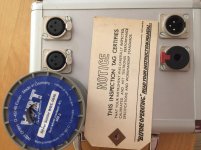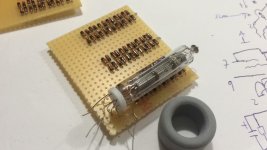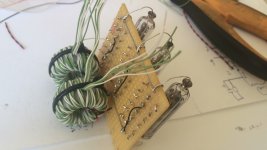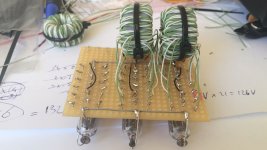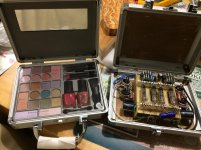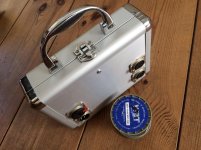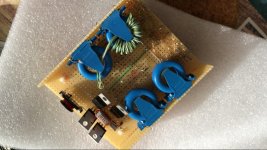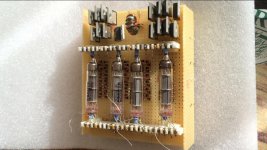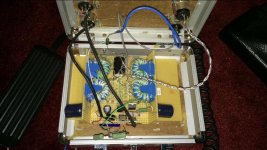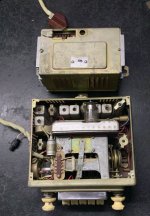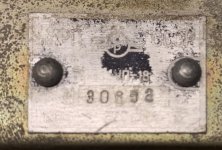Yes, i love to read the comments here in the forum as long as the competition is about having fun with audio and our electronics hobby. I see many people advertising their products and that is ok too but then the thread has a different tone to it. I have a choice to comment or not. Usually i stay out of these. But true , here we are one nation, the DIY nation!
Last edited:
This is something I've always liked about pure science and mathematics. At a typical research conference you see presenters from dozens of different countries, and people's reputations are mostly based on their merits and body of work, not on nationalism or the typical other petty stuff (wealth, eye colour, hair colour, gender, appearance, et cetera.)isnt it nice how electronics lets you unite three or more competing nations together peacefully?
-Gnobuddy
Unfortunately the reality is not always like you describe in real life but it should !
I have seen the movie "imitation game“, although it is just a movie it shows that it has not always been this way. I guess we still have some work to do in this matter. Here in the forum however all seems peaceful as long as we stay on topic.
So I will stop now ha ha.
I have seen the movie "imitation game“, although it is just a movie it shows that it has not always been this way. I guess we still have some work to do in this matter. Here in the forum however all seems peaceful as long as we stay on topic.
So I will stop now ha ha.
I too hope we can have some fun.
I belong to a local audio club. All kinds of people from all over the world. That club is there for us to have fun.
I think we all need to unsolder all our old amplifiers, get the Lead out, and re-solder them with silver solder. There is a ban on Lead solder, isn't there? Where do I re-cycle the old Lead solder I take out of the amplifiers? Now, where did I place my Lead Acid Car Battery I was re-charging . . . I need to re-install it in my car.
I hear Mercury was also banned. Now where did I put those (Mercury) CFC light bulbs? We need to be more energy efficient, Tungsten took too much power. I am glad we are catching up, now we have LED light bulbs.
I belong to a local audio club. All kinds of people from all over the world. That club is there for us to have fun.
I think we all need to unsolder all our old amplifiers, get the Lead out, and re-solder them with silver solder. There is a ban on Lead solder, isn't there? Where do I re-cycle the old Lead solder I take out of the amplifiers? Now, where did I place my Lead Acid Car Battery I was re-charging . . . I need to re-install it in my car.
I hear Mercury was also banned. Now where did I put those (Mercury) CFC light bulbs? We need to be more energy efficient, Tungsten took too much power. I am glad we are catching up, now we have LED light bulbs.
Last edited:
...we all need to unsolder all our old amplifiers, get the Lead out, .... Where do I re-cycle the old Lead solder I take out of the amplifiers? Now, where did I place my Lead Acid Car Battery....
95% of lead in the US is recycled. When normal people get a car battery replaced, the dud goes back to Pennsylvania where the "lead", acid, and plastic are broke-down and reconstituted as new batteries.
So collect your scrap lead solder and brush it into the top of the next battery you take-back to the store. Yes it has some Tin, but Lead always has Tin, and Tin is valuable. East Penn will skim the Tin and sell it, or use it to harden soft Lead.
Lead has a scrap price but it is less than the cost to transport unless you have a 1000-pound skid of Lead (batteries). Maybe $0.20/pound for a bucketful of dirty Lead. (If you could assay the Tin, pure Tin is ~~$20/lb, but household solder is not worth an assay.)
PRR,
Thanks!
That is actually one of the best re-cycling programs out there.
But I still worry that some of the process can let some of the Lead get away and contaminate the worker, the ground, the water, the area, etc.
As to mercury, if you drop a CFC bulb and it breaks on your rug, the suggested process is this:
1. Open all the windows, go outside and wait 15 minutes
2. While you are outside, call the hazardous organization in your area responsible for cleaning the mercury up.
3. When the hazz matt group comes to your house, they will cut out a 3 by 3 foot section of your rug, and bring it and the CFC bulb with them.
4. This process is hardly ever followed, because of four things:
A. Nobody knows that is what they are supposed to do.
B. Nobody knows what phone number to call.
C. They do not want to replace the 3 by 3 foot section of the rug.
D. Most municipal areas do not have a Hazardous Material group that performs this service. Just try and find a Hazz Matt group in a remote area of the Rockies.
Thanks!
That is actually one of the best re-cycling programs out there.
But I still worry that some of the process can let some of the Lead get away and contaminate the worker, the ground, the water, the area, etc.
As to mercury, if you drop a CFC bulb and it breaks on your rug, the suggested process is this:
1. Open all the windows, go outside and wait 15 minutes
2. While you are outside, call the hazardous organization in your area responsible for cleaning the mercury up.
3. When the hazz matt group comes to your house, they will cut out a 3 by 3 foot section of your rug, and bring it and the CFC bulb with them.
4. This process is hardly ever followed, because of four things:
A. Nobody knows that is what they are supposed to do.
B. Nobody knows what phone number to call.
C. They do not want to replace the 3 by 3 foot section of the rug.
D. Most municipal areas do not have a Hazardous Material group that performs this service. Just try and find a Hazz Matt group in a remote area of the Rockies.
It shows the original content of the case..
The 6P30B tube could be used as well here and maybe even more powerful.
The 6P30B tube could be used as well here and maybe even more powerful.
Attachments
Last edited:
What is the toroids in the photos?
Regards
Ddimitrios
Do a search for David Berning architecture, ZOTL, in this case it is a Micro Zotl. http://www.davidberning.com/images/microZOTL/microZOTL_Manual.pdf
In these amplifiers the audio sicnal is riding on a RF carrier so that RF toroid transformers can be used for OPTs.
oh wow. i havent seen this thread in ages!
and i havent bothered doing anything electrical in ages, either!
but the bug bit.
and i woke up the other morning with the schematic in my head. the trick? a joule thief with a third winding, giving isolated HT (22V unloaded, sag to 15 when tubes lit) story of my life. let things stew in the subconscious for a few years... and one day it suddenly makes sense! then it takes another two weeks to find everything strewn about the shed...
cathode follower (bootstrapped high impedance input/low impedance output for piezo pickup) running off ONE NiMH.
1Ж29Б soviet rod tube. Battery powered valve preamplifier for acoustic guitar. One NiMH cell! - YouTube
feel free to criticise nothing you say can be worse than what i can say about me!
nothing you say can be worse than what i can say about me!
its now on a bit of veroboard. figuring out how to mount it without drilling my guitar... as i hoped, once its reduced in size and not on breadboard it stopped hissing so bad. of course, should be even better once its shielded in a lil bit of metal. the JT runs at about 400K, so even if it was managing to get past the filter cap, its beyond audible. scope shows no ripple, anyway.
had no luck using any type of self or fixed bias other than gridleak to -neg of filament. and that -1.2 bias seems to work regardless of what loads and screen resistors i throw in there from 10k to 220k. virtually no tonal changes besides some screen compression as you get over 56k on the screen.
i was finding 47-56k gives best gain.
they are pretty microphonic, too. hope it doesnt become an issue when mounted to a vibrating guitar body...
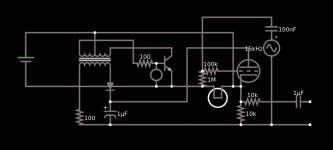
about as simple a circuit as one can get HT voltage is all about how the JT is wound, results may vary...
HT voltage is all about how the JT is wound, results may vary...
high speed diode on the rectifier. fr102 is what i had handy.
stupid simulation gets grumpy... works. then it doesnt.
reference screen to cathode obviously, 10-100k, bypass with cap to cat if you want for more bass. (pins 1,2,5 all "ground" or cathode, or nimh +pos, 4,6 and grid leak to nimh -neg.)
um. little circle on NPN base is an LED, cat to base. (lights up on backspike from base winding of inductor).
assume the bulb to be the filament.
could probably use the cat as the ground reference, and take the output from the HT neg- rail instead... lets the plug/jack switch power on then.
and i havent bothered doing anything electrical in ages, either!
but the bug bit.
and i woke up the other morning with the schematic in my head. the trick? a joule thief with a third winding, giving isolated HT (22V unloaded, sag to 15 when tubes lit) story of my life. let things stew in the subconscious for a few years... and one day it suddenly makes sense! then it takes another two weeks to find everything strewn about the shed...
cathode follower (bootstrapped high impedance input/low impedance output for piezo pickup) running off ONE NiMH.
1Ж29Б soviet rod tube. Battery powered valve preamplifier for acoustic guitar. One NiMH cell! - YouTube
feel free to criticise
its now on a bit of veroboard. figuring out how to mount it without drilling my guitar... as i hoped, once its reduced in size and not on breadboard it stopped hissing so bad. of course, should be even better once its shielded in a lil bit of metal. the JT runs at about 400K, so even if it was managing to get past the filter cap, its beyond audible. scope shows no ripple, anyway.
had no luck using any type of self or fixed bias other than gridleak to -neg of filament. and that -1.2 bias seems to work regardless of what loads and screen resistors i throw in there from 10k to 220k. virtually no tonal changes besides some screen compression as you get over 56k on the screen.
i was finding 47-56k gives best gain.
they are pretty microphonic, too. hope it doesnt become an issue when mounted to a vibrating guitar body...

about as simple a circuit as one can get
high speed diode on the rectifier. fr102 is what i had handy.
stupid simulation gets grumpy... works. then it doesnt.
reference screen to cathode obviously, 10-100k, bypass with cap to cat if you want for more bass. (pins 1,2,5 all "ground" or cathode, or nimh +pos, 4,6 and grid leak to nimh -neg.)
um. little circle on NPN base is an LED, cat to base. (lights up on backspike from base winding of inductor).
assume the bulb to be the filament.
could probably use the cat as the ground reference, and take the output from the HT neg- rail instead... lets the plug/jack switch power on then.
Soviet car radio
This is only tangentially related to the above thread...
I purchased this Soviet car radio on eBay, as I was curious and the seller said it works. It has AM and OIRT band FM (66 to 73MHz). It apparently came from a GAZ Volga and pictures I saw confirm that.
Beyond that, I know nothing. In fact, until I lifted the top cover, I did not know it had vacuum tubes. The accompanying power supply (and power amp?) has transistors.
I would very much appreciate getting any info on it. Obviously a schematic would be great but even knowing it is 6 or 12V and negative / positive ground would be very helpful.
Many thanks.
This is only tangentially related to the above thread...
I purchased this Soviet car radio on eBay, as I was curious and the seller said it works. It has AM and OIRT band FM (66 to 73MHz). It apparently came from a GAZ Volga and pictures I saw confirm that.
Beyond that, I know nothing. In fact, until I lifted the top cover, I did not know it had vacuum tubes. The accompanying power supply (and power amp?) has transistors.
I would very much appreciate getting any info on it. Obviously a schematic would be great but even knowing it is 6 or 12V and negative / positive ground would be very helpful.
Many thanks.
Attachments
This could be your russian radio, a Murom A-18.
More information here: A-18 {А-18} Car Radio Murom Radio Works, build 1967, 12 pict
It is a hybrid, RF section has 6 tubes, AF amp has 6 transistors.
Used converter block "up-18" for anode supply, ЧП-18 label.
Preset (pushbuttons) of six fixed radio stations. Radio set for russian car VOLGA "gaz-21".
Powered from 12v with built-in up-converter to 135V.
As a guest you can download the schematic through this link : Schema Download
video: Restored Murom A-18 old Soviet Union car radio from 1967 working.... - YouTube
More information here: A-18 {А-18} Car Radio Murom Radio Works, build 1967, 12 pict
It is a hybrid, RF section has 6 tubes, AF amp has 6 transistors.
Used converter block "up-18" for anode supply, ЧП-18 label.
Preset (pushbuttons) of six fixed radio stations. Radio set for russian car VOLGA "gaz-21".
Powered from 12v with built-in up-converter to 135V.
As a guest you can download the schematic through this link : Schema Download
video: Restored Murom A-18 old Soviet Union car radio from 1967 working.... - YouTube
Last edited:
- Status
- This old topic is closed. If you want to reopen this topic, contact a moderator using the "Report Post" button.
- Home
- Amplifiers
- Tubes / Valves
- 1P24B Russian tube
